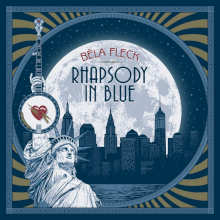The Graham Album Review #2190

Click on CD Cover for Audio Review in streaming mp3 format | |
Béla Fleck: Rhapsody in Blue
(Independent release, as broadcast on WVIA-FM 3/13/2024)

Click on CD Cover for Audio Review in streaming mp3 format | |
Béla Fleck: Rhapsody in Blue
(Independent release, as broadcast on WVIA-FM 3/13/2024)
One of the most eclectic musicians anywhere, in my view, is Béla Fleck, who happens to play the banjo, an instrument that is among the least flexible and expressive. Famously limited in pitch range, with no sustain and very little ability to convey dynamics, the banjo nevertheless has a long history, as part of many cultures originating in Africa. Of course in this country, the banjo is best known these days for being a staple of bluegrass, but was also a part of early jazz, and before that various folk traditions.
A native New Yorker, Béla Fleck, over a forty year career, seems driven to take the banjo to places where no banjo has gone before. He began in bluegrass in his teens, but soon became part of the eclectic New Acoustic movement than performed jazz influenced instrumental music on the instrumentation of bluegrass. He was also part of the influential group New Grass Revival. And over the years, he formed the funk-fusion band The Flecktones, recorded with jazz musicians, including Chick Corea, traveled to Africa and recorded with African folk and pop musicians, and also turned his attention to classical, doing banjo versions of Paganini, Bach and Beethoven. Recently he won another Grammy award for his back-to-bluegrass album My Bluegrass Heart. And he has done other recent world music projects.
Béla Fleck’s latest opus of banjo eclecticism is his tackling of a very familiar orchestral piece, George Gershwin’s Rhapsody in Blue. And Rhapsody in Blue is also the name of Fleck’s album. And once again, the banjomeister has taken on the challenge of adapting and performing the very un-banjo-like music on his instrument, taking on the role of the piano soloist in Rhapsody in Blue.
This album is also unusual, even for Fleck, in that it features three different versions of Gershwin’s masterpiece, each rather lengthy, including a 19 minute performance of the piece with full orchestra. He also does what he calls Rhapsody in Bluegrass and Rhapsody in Blue(s), along with two lesser known Gershwin pieces, including one written specifically for the banjo. On his website, Fleck talks about the challenges of trying to play the piano parts on the banjo, and his efforts at adapting arrangements to his instrument. As usual, when Fleck gives himself a challenge like that, he succeeds brilliantly. The pandemic, and the inability to perform live, gave him the opportunity and perhaps the incentive to undertake this project.
Opening is the first of the three version of the Gershwin work, Rhapsody in Bluegrass, and abridged version that sill maintains many of the orchestral themes. Fleck is joined by an all-star bluegrass ensemble consisting of fiddler Michael Cleveland, Dobro player Justin Moses, guitarist Bryan Sutton, mandolinist Sierra Hull, and bassist Mark Schatz. The arrangement initially maintains the rhythmic structure of the symphonic work <<>> but then gets nice and bluegrassy. Some of the piano cadenzas of the original provide space of the band to stretch out. <<>>
That is followed by a Gershwin composition that Fleck says that his friend and musicology professor Ryan Banagale discovered in the Library of Congress. It had not been previously recorded, or indeed even named. It’s labeled as Unidentified Piece for Banjo, a composition that Gershwin actually wrote for the instrument. Fleck performs it solo on an older style gut-string banjo for authenticity. <<>>
Following that is a full orchestral version of Rhapsody in Blue with the Virginia Symphony Orchestra conducted by Eric Jacobson, and Fleck performing the piano part on his banjo. Fleck writes that is was a challenge with the banjo only able to play three notes at a time and a pianist’s ability to play notes more rapidly. Still Fleck’s adaptation is impressive. <<>> Fleck’s treatment of the original piano cadenzas really shines. <<>>
After that is Rhapsody in Blue(s), an abridged version with a bluesy treatment, in which Fleck is joined by Victor Wooten of the Flecktones on electric bass, Jerry Douglas on the Dobro and Sam Bush on mandolin. You can tell they were having fun with this. <<>>
The album ends with another Gershwin piece, Rialto Ripples written as a ragtime piano piece. Fleck gives it rather gentle but whimsical treatment. <<>>
Bela Fleck’s new project Rhapsody in Blue is another great example of this paragon of musical eclecticism taking his banjo to uncharted territory, tackling the familiar Gershwin classical piece in three different ways, and accepting the challenge of performing the virtuoso piano parts on his banjo. The result succeeds quite well, and makes for absorbing listening, and with the banjo, it can’t help but be a little lighthearted. The accompanying musicians who play on the bluegrass and blues versions are first rate, and the arrangements clever.
Our grade for audio quality is an “A.” The album is recorded like a classical album, with a nice full dynamic range, a real rarity these days.
It turns out that the release of this album coincided with the 100th anniversary of the premiere of Rhapsody in Blue, in February 1924. Fleck on his website says he wonders what Gershwin would have thought of this adaptation for banjo. Gershwin is not around to provide his opinion, but I think it’s both impressive and fun.
(c) Copyright 2024 George D. Graham. All rights reserved.
This review may not be copied to another Web site without written permission.
 To Index of Album Reviews | To George Graham's Home Page. | What's New on This Site.
To Index of Album Reviews | To George Graham's Home Page. | What's New on This Site.